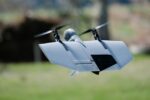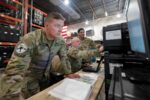Germany has formally selected the Saab GlobalEye as its preferred solution to fulfill future airborne early warning and control (AEW&C) requirements. This decision marks a significant step toward replacing the aging NATO-operated Boeing E-3A Sentry fleet and modernizing German air surveillance capability within the alliance framework.
From E-3A to GlobalEye: A Strategic Leap in AEW&C Capability
The German Ministry of Defence (BMVg) confirmed in September 2025 that it will prioritize procurement of the Saab GlobalEye multi-domain AEW&C platform. This selection comes amid growing urgency to replace NATO’s aging fleet of Boeing E-3A Sentry aircraft—originally fielded in the early 1980s—with a modern system capable of operating in contested electromagnetic environments and supporting multi-domain operations.
The Luftwaffe does not currently operate its own AEW&C fleet but contributes personnel and support to NATO’s Airborne Early Warning and Control Force (NAEW&CF), headquartered at Geilenkirchen Air Base. With this acquisition, Germany is poised to establish a sovereign AEW&C capability that complements NATO assets while ensuring national operational autonomy.
Why GlobalEye? Platform Capabilities and Strategic Fit
Saab’s GlobalEye is a long-range AEW&C platform based on the Bombardier Global 6000/6500 business jet airframe. It integrates the Erieye Extended Range (ER) radar—a gallium nitride (GaN)-based active electronically scanned array (AESA)—mounted atop the fuselage. The radar offers over 550 km detection range for aerial targets and can simultaneously track surface vessels and ground vehicles using synthetic aperture radar (SAR) modes.
- Multi-domain surveillance: Simultaneous air, maritime, and ground target tracking
- High endurance: Up to 11 hours on station with inflight refueling capability
- Sensor fusion: Combines radar data with EO/IR sensors, SIGINT payloads
- NATO interoperability: Link-16 compatible; supports network-centric operations
This combination makes GlobalEye particularly suited for modern threat environments characterized by low-observable platforms (e.g., cruise missiles), electronic warfare activity, and hybrid threats across domains. The platform has already been adopted by Sweden, UAE, Brazil (as part of Erieye legacy), Finland, and Canada—underscoring its growing credibility within Western defense circles.
NATO Context: Replacing the E-3A Sentry Fleet
NATO operates a fleet of 14 Boeing E-3A Sentry aircraft under its NAEW&CF program. These AWACS platforms are based at Geilenkirchen AB but are nearing obsolescence due to age-related fatigue issues and limited upgrade potential. In June 2023, NATO launched its Alliance Future Surveillance Capability (AFSC) initiative aimed at identifying replacements by the early-to-mid 2030s.
The German move aligns with broader European efforts to field national or regional AEW&C capabilities that can plug into NATO command networks while offering sovereign control during crises. France operates four modified Boeing E-3F aircraft; Italy uses Gulfstream-based CAEW systems; Poland recently ordered two Saab GlobalEyes in July 2024 under an urgent operational requirement.
Luftwaffe Plans: Procurement Timeline Still Unclear
While Germany has now prioritized GlobalEye as its preferred solution, no formal contract has yet been signed as of October 2025. Defense officials have indicated that negotiations with Saab are ongoing regarding quantity, configuration options (e.g., SIGINT modules), industrial participation by German firms such as Hensoldt or ESG Elektroniksystem- und Logistik-GmbH, and delivery timelines.
An initial batch of three to five aircraft is expected based on current planning assumptions. If finalized within FY2026 defense budgets—which have earmarked funds under Germany’s €100 billion “Sondervermögen” special defense fund—deliveries could begin around late 2027 or early 2028. This would position Germany among Europe’s leading contributors to NATO’s future ISR architecture.
Operational Implications for German C4ISR Posture
The addition of a sovereign AEW&C capability would significantly enhance Germany’s C4ISR posture across multiple dimensions:
- Aerial Battle Management: Real-time tracking of hostile aircraft/missiles over Eastern Europe or Baltic Sea regions
- Crisis Response: Rapid deployment in hybrid threat scenarios involving Russia or gray-zone actors
- Tactical Data Relay: Acting as airborne node for Link-16/MIDS networks connecting Eurofighters, IRIS-T SL batteries, or naval units
- SIGINT/ELINT Potential: Depending on configuration choices made during procurement phase
This acquisition also complements Germany’s investments in other ISR domains—including Hensoldt TRML-series radars for GBAD systems like IRIS-T SLX/SLS—and signals an intent to build layered situational awareness from space-based assets down through tactical edge sensors.
Challenges Ahead: Industrial Offsets & Budgetary Pressures
A key challenge will be balancing rapid acquisition timelines with domestic industrial offsets demanded by Berlin policymakers. Saab has previously partnered with local firms—such as Embraer in Brazil or Patria in Finland—to localize MRO support or sensor integration workstreams. Similar arrangements may be required with German primes like Airbus Defence & Space or Rohde & Schwarz if Berlin wants long-term sustainment sovereignty.
Additionally, despite earmarked Sondervermögen funds post-Russian invasion of Ukraine in February 2022, competing priorities—including FCAS development costs and Puma IFV modernization—could delay full-scale procurement unless political consensus is maintained through upcoming Bundestag budget cycles.
A Step Toward European Strategic Autonomy?
The move toward acquiring GlobalEye also fits into wider debates about European strategic autonomy within NATO frameworks. By fielding interoperable yet nationally controlled ISR assets like AEW&C aircraft—and potentially MALE UAVs such as Eurodrone—Germany positions itself not only as a net contributor but also as a leader shaping future coalition ISR architectures independent from U.S.-centric platforms like JSTARS or Rivet Joint fleets.









